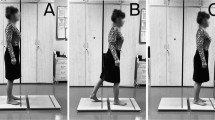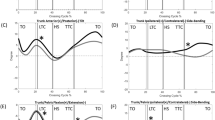Abstract
Neuromuscular impairments in Parkinson’s disease (PD) alter the mechanics and control of the body, leading to an increased risk of falling during more challenging functional tasks such as obstacle-crossing. However, little is known about these changes. The current study aimed to bridge the gap by quantifying the motion of the body’s center of mass (COM) relative to the center of pressure (COP) in terms of COM-COP inclination angles (IA) and their rate of change (RCIA) in fifteen older adults with mild PD and fifteen healthy controls when crossing obstacles of heights of 10, 20 and 30% leg length. There were no between-group differences for either the leading or trailing toe clearances (p > 0.05). With the unaffected limb leading, the PD subjects significantly increased the crossing sagittal and frontal IA, crossing sagittal RCIA, the peak RCIA, and average sagittal and frontal RCIAs during double-limb support for all obstacle heights when compared to those with the affected limb leading and those of the Controls (p < 0.05). The poor balance control in the mediolateral direction during obstacle-crossing in PD indicated an increased risk of falling. The differences in the crossing patterns between leading with the affected or unaffected limb suggest that patients with PD should lead with the affected limb when crossing obstacles. The current findings suggest that early dynamic balance training is important in the management of patients with PD.


Similar content being viewed by others
References
Fung, H. C., Chen, C. M., Hardy, J., Singleton, A. B., Lee-Chen, G. J., & Wu, Y. R. (2006). Analysis of the PINK1 gene in a cohort of patients with sporadic early-onset parkinsonism in Taiwan. Neuroscience Letters, 394(1), 33–36.
Melton, L. J., Leibson, C. L., Achenbach, S. J., Bower, J. H., Maraganore, D. M., Oberg, A. L., et al. (2006). Fracture risk after the diagnosis of Parkinson’s disease: influence of concomitant dementia. Movement Disorders, 21(9), 1361–1367.
Mortimer, J. A., Pirozzolo, F. J., Hansch, E. C., & Webster, D. D. (1982). Relationship of motor symptoms to intellectual deficits in Parkinson disease. Neurology, 32(2), 133–133.
Albin, R. L., Young, A. B., & Penney, J. B. (1989). The functional anatomy of basal ganglia disorders. Trends in Neurosciences, 12(10), 366–375.
McIntosh, G. C., Brown, S. H., Rice, R. R., & Thaut, M. H. (1997). Rhythmic auditory-motor facilitation of gait patterns in patients with Parkinson’s disease. Journal of Neurology, Neurosurgery and Psychiatry, 62(1), 22–26.
Carpenter, M., Allum, J., Honegger, F., Adkin, A., & Bloem, B. (2004). Postural abnormalities to multidirectional stance perturbations in Parkinson’s disease. Journal of Neurology, Neurosurgery and Psychiatry, 75(9), 1245–1254.
Alexander, B. H., Rivara, F. P., & Wolf, M. E. (1992). The cost and frequency of hospitalization for fall-related injuries in older adults. American Journal of Public Health, 82(7), 1020–1023.
Dibble, L. E., & Lange, M. (2006). Predicting falls in individuals with Parkinson disease: a reconsideration of clinical balance measures. Journal of Neurologic Physical Therapy, 30(2), 60–67. doi:10.1097/1001.NPT.0000282569.0000270920.dc.
Nieuwboer, A., Chavret, F., Willems, A. M., & Desloovere, K. (2007). Does freezing in Parkinson’s disease change limb coordination? Journal of Neurology, 254(9), 1268–1277.
Roiz, Rd M, Cacho, E. W. A., Pazinatto, M. M., Reis, J. G., Cliquet, A., Jr., & Barasnevicius-Quagliato, E. (2010). Gait analysis comparing Parkinson’s disease with healthy elderly subjects. Arquivos de Neuro-Psiquiatria, 68(1), 81–86.
Ebersbach, G., Moreau, C., Gandor, F., Defebvre, L., & Devos, D. (2013). Clinical syndromes: Parkinsonian gait. Movement Disorders, 28(11), 1552–1559.
Alexander, G. E., & Crutcher, M. D. (1990). Functional architecture of basal ganglia circuits: neural substrates of parallel processing. Trends in Neurosciences, 13(7), 266–271.
Lockhart, P. J., Bounds, R., Hulihan, M., Kachergus, J., Lincoln, S., Lin, C. H., et al. (2004). Lack of mutations in DJ-1 in a cohort of Taiwanese ethnic Chinese with early-onset parkinsonism. Movement Disorders, 19(9), 1065–1069.
Lewek, M. D., Poole, R., Johnson, J., Halawa, O., & Huang, X. (2010). Arm swing magnitude and asymmetry during gait in the early stages of Parkinson’s disease. Gait & Posture, 31(2), 256–260.
Rogers, M. W. (1996). Disorders of posture, balance, and gait in Parkinson’s disease. Clinics in Geriatric Medicine, 12(4), 825–845.
Bloem, B. R., Grimbergen, Y. A., Cramer, M., Willemsen, M., & Zwinderman, A. H. (2001). Prospective assessment of falls in Parkinson’s disease. Journal of Neurology, 248(11), 950–958.
Vitório, R., Pieruccini-Faria, F., Stella, F., Gobbi, S., & Gobbi, L. T. B. (2010). Effects of obstacle height on obstacle crossing in mild Parkinson’s disease. Gait & Posture, 31(1), 143–146.
Stegemöller, E. L., Buckley, T. A., Pitsikoulis, C., Barthelemy, E., Roemmich, R., & Hass, C. J. (2012). Postural instability and gait impairment during obstacle crossing in Parkinson’s disease. Archives of Physical Medicine and Rehabilitation, 93(4), 703–709.
Blake, A. J., Morgan, K., Bendall, M., Dallosso, H., Ebrahim, S., Arie, T., et al. (1988). Falls by elderly people at home: prevalence and associated factors. Age and Ageing, 17(6), 365–372.
Hoyert, D. L., Arias, E., Smith, B. L., Murphy, S. L., & Kochanek, K. D. (2001). Deaths: final data for 1999. National vital statistics reports: from the Centers for Disease Control and Prevention, National Center for Health Statistics, National Vital Statistics System, 49(8), 1–113.
Pandya, N. K., Draganich, L. F., Mauer, A., Piotrowski, G. A., & Pottenger, L. (2005). Osteoarthritis of the knees increases the propensity to trip on an obstacle. Clinical Orthopaedics and Related Research, 431, 150–156.
Lu, T. W., Chen, H. L., & Chen, S. C. (2006). Comparisons of the lower limb kinematics between young and older adults when crossing obstacles of different heights. Gait & Posture, 23(4), 471–479.
Dietz, V., & Michel, J. (2008). Locomotion in Parkinson’s disease: neuronal coupling of upper and lower limbs. Brain, 131(12), 3421–3431.
Patla, A. (1990). Assessment of balance control in the elderly: major issues. Physiotherapy Canada, 42(2), 89–97.
Kuo, A. D. (1995). An optimal control model for analyzing human postural balance. IEEE Transactions on Biomedical Engineering, 42(1), 87–101.
Patla, A. E. (2003). Strategies for dynamic stability during adaptive human locomotion. IEEE Engineering in Medicine and Biology Magazine, 22(2), 48–52.
Lee, H. J., & Chou, L. S. (2006). Detection of gait instability using the center of mass and center of pressure inclination angles. Archives of Physical Medicine and Rehabilitation, 87(4), 569–575.
Hsu, W. C., Wang, T. M., Liu, M. W., Chang, C. F., Chen, H. L., & Lu, T. W. (2010). Control of body’s center of mass motion during level walking and obstacle-crossing in older patients with knee osteoarthritis. Journal of Mechanics, 26(02), 229–237.
Huang, S. C., Wei, I. P., Chien, H. L., Wang, T. M., Liu, Y. H., Chen, H. L., et al. (2008). Effects of severity of degeneration on gait patterns in patients with medial knee osteoarthritis. Medical Engineering & Physics, 30(8), 997–1003.
Chien, H. L., Lu, T. W., & Liu, M. W. (2013). Control of the motion of the body’s center of mass in relation to the center of pressure during high-heeled gait. Gait & Posture, 38(3), 391–396.
Pai, Y. C., & Patton, J. (1997). Center of mass velocity-position predictions for balance control. Journal of Biomechanics, 30, 347–354.
Lu, T. W., Chen, H. L., & Wang, T. M. (2007). Obstacle crossing in older adults with medial compartment knee osteoarthritis. Gait & Posture, 26(4), 553–559.
Dempster, W. T., Gabel, W. C., & Felts, W. J. (1959). The anthropometry of the manual work space for the seated subject. American Journal of Physical Anthropology, 17(4), 289–317.
Lu, T. W., Chien, H. L., & Chen, H. L. (2007). Joint loading in the lower extremities during elliptical exercise. Medicine and Science in Sports and Exercise, 39(9), 1651.
Hsieh, H. J., Lu, T. W., Chen, S. C., Chang, C. M., & Hung, C. (2011). A new device for in situ static and dynamic calibration of force platforms. Gait & Posture, 33(4), 701–705.
Huang, S. C., Lu, T. W., Chen, H. L., Wang, T. M., & Chou, L. S. (2008). Age and height effects on the center of mass and center of pressure inclination angles during obstacle-crossing. Medical Engineering & Physics, 30(8), 968–975.
Woltring, H. J. ((1986)). A FORTRAN package for generalized, cross-validatory spline smoothing and differentiation. Advances in Engineering Software (1978), 8(2), 104–113.
Morris, M., Iansek, R., McGinley, J., Matyas, T., & Huxham, F. (2005). Three-dimensional gait biomechanics in Parkinson’s disease: Evidence for a centrally mediated amplitude regulation disorder. Movement Disorders, 20(1), 40–50.
Konczak, J., Corcos, D. M., Horak, F., Poizner, H., Shapiro, M., Tuite, P., et al. (2009). Proprioception and motor control in Parkinson’s disease. Journal of Motor Behavior, 41(6), 543–552.
Galna, B., Murphy, A. T., & Morris, M. E. (2010). Obstacle crossing in people with Parkinson’s disease: foot clearance and spatiotemporal deficits. Human Movement Science, 29(5), 843–852.
Hausdorff, J. M., Cudkowicz, M. E., Firtion, R., Wei, J. Y., & Goldberger, A. L. (1998). Gait variability and basal ganglia disorders: Stride-to-stride variations of gait cycle timing in Parkinson’s disease and Huntington’s disease. Movement Disorders, 13(3), 428–437.
Chou, L. S., Kaufman, K. R., Hahn, M. E., & Brey, R. H. (2003). Medio-lateral motion of the center of mass during obstacle crossing distinguishes elderly individuals with imbalance. Gait & Posture, 18(3), 125–133.
Jacobs, J., & Horak, F. (2006). Abnormal proprioceptive-motor integration contributes to hypometric postural responses of subjects with Parkinson’s disease. Neuroscience, 141(2), 999–1009.
Chen, H. L., & Lu, T. W. (2006). Comparisons of the joint moments between leading and trailing limb in young adults when stepping over obstacles. Gait & Posture, 23(1), 69–77.
Frank, J., Horak, F., & Nutt, J. (2000). Centrally initiated postural adjustments in parkinsonian patients on and off levodopa. Journal of Neurophysiology, 84(5), 2440–2448.
Stolwyk, R. J., Triggs, T. J., Charlton, J. L., Moss, S., Iansek, R., & Bradshaw, J. L. (2006). Effect of a concurrent task on driving performance in people with Parkinson’s disease. Movement Disorders, 21(12), 2096–2100.
Acknowledgements
The authors are grateful for the financial support from the National Science Council, Taiwan (NSC 98-2320-B-002-005-MY3). The assistance in data collection provided by Drs Chu-Fen Chang and Sheng-Chang Chen is also greatly appreciated.
Author information
Authors and Affiliations
Corresponding author
Ethics declarations
Conflict of interest
The authors declare that they have no conflict of interest.
Rights and permissions
About this article
Cite this article
Liu, YH., Kuo, MY., Wu, RM. et al. Control of the Motions of the Body’s Center of Mass and End-Points of the Lower Limbs in Patients with Mild Parkinson’s Disease During Obstacle-Crossing. J. Med. Biol. Eng. 38, 534–543 (2018). https://doi.org/10.1007/s40846-017-0329-y
Received:
Accepted:
Published:
Issue Date:
DOI: https://doi.org/10.1007/s40846-017-0329-y




